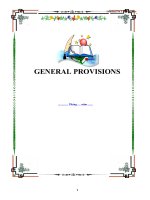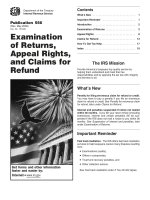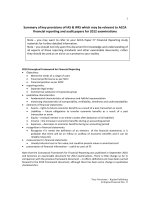Claims Provisions
Bạn đang xem bản rút gọn của tài liệu. Xem và tải ngay bản đầy đủ của tài liệu tại đây (232.35 KB, 16 trang )
FSAP
Actuarial Valuation of
General Insurance Claims Provisions
Instituto de Seguros de Portugal
01/02/2006
Claims Provisions
Summary
1. Underlying principles
2. Information reported by insurance undertakings
3. Supervisory process
3.1. Ratio Analysis
3.2. Statistical Approaches
4. Responsible actuaries practice
Claims Provisions
1. Underlying principles
• Adequate claims provisions are essential for the financial
soundness of general insurance companies
• Claims provisions should correspond to a reasonably
conservative estimate of the amount of future payments
arising from claims incurred before the valuation date:
Claims Reported to the insurance company
Claims Incurred but Not Reported (IBNR)
Claims Management Costs
• Statistical methods are commonly used for the estimation
of claims provisions
Claims Provisions
2. Information reported by insurance undertakings
• ISP supervisory analysis is based on:
Responsible Actuary’s report
Auditor’s appraisal
Run-off triangles (claims paid, claims provision, number of
claims) for main LOB’s:
Motor (also by coverage)
Property claims
Liability claims
Workers’ compensation
Temporary incapacity
Long-term assistance
Health
Individual insurance
Group insurance
Other relevant statistical data (e.g. premiums, number of
policies, Claims settlement expenses, etc.)
• Data quality is crucial
Claims Provisions
3. ISP Supervisory Process
• ISP pays particular attention to the responsible actuary’s
critical analysis of the claims provision estimates
• Several ratios are computed and analysed
• ISP runs various statistical methods (deterministic and
stochastic) to estimate the expected value and variability
of the claims provision
• A detailed technical and practical manual is available to
ISP supervision staff as a guidance for the analysis of
claims provisioning (off-site and on-site analysis)
Claims Provisions
3.1. Ratio Analysis
•
Ratios and indicators considered on ISP analysis of claims
provisions:
Growth on Premiums
Average Premium
Loss Ratio
Average Cost of New Claims
Average Claims Provision
Claims Frequency
Development of Claims Payments
“Speed” of Process closure
Re-openings
Claims Expenses
Provisioning, including IBNR
Readjustments
•
Ratios are calculated individually and compared on a static and
evolutionary perspective with peer group and market benchmarks
Claims Provisions
3.2. Statistical Approaches
• The statistical methods’ objective is to project the
expected future claims experience, using assumptions
based on past data analysis complemented with expert
opinion
• The analysis should consist of:
Analysis of results (particularly the estimation error),
taking into account the theoretical assumptions
underlying each model
Analysis of relevant graphs and hypothesis tests to assess
each models’ fitness
Claims Provisions
3.2. Statistical Approaches (cont.)
• Format of a Run-off triangle representing accident year x development
year
• Run-off triangles may refer to:
Number of claims
Claims paid (common approach)
Claims incurred, i.e. Claims paid + Claims provision
Accident year
• Aim is to estimate the lower unknown
triangle (shaded):
Development year
1997
1998
1999
2000
2001
2002
2003
2004
2005
0
45.591
48.639
50.007
53.871
55.158
49.106
51.372
53.832
50.825
1
17.534
20.062
28.797
30.759
29.658
30.203
28.112
27.492
2
5.430
5.460
7.722
7.750
8.802
7.369
7.501
3
4.700
3.988
6.474
5.121
5.297
7.250
4
3.486
3.655
5.269
4.205
5.189
5
2.821
4.556
4.859
5.725
6
3.590
2.390
4.074
7
2.728
2.740
8
2.003
>8
1.358
(m.u.: thousand euros)
Claims Provisions
3.2. Statistical Approaches (cont.)
• Deterministic methods
Projection of past claims experience assuming fixed
development factors
Provides point estimates of the expected future claims amounts
Various actuarial techniques are available
• Stochastic models
Random nature of variables is considered
Generally speaking, the future claims amounts are assumed to
follow a specified probability distribution
Allows for the measurement of the estimates variability,
essential for the construction of confidence intervals for the
estimates
Various actuarial models are available
Claims Provisions
3.2. Statistical Approaches (cont.)
Statistical Methods available at ISP
• ISP has in-house built programs that allow for the automatic
testing of the following statistical methods:
Deterministic
Stochastic
Grossing Up
Thomas Mack Model
Link Ratio
Generalised Linear Models:
Chain-Ladder
Over-dispersed Poisson
Taylor
Gamma
Loss Ratio
Inverse Gaussian
Bornhuetter-Ferguson
Loglinear Model (Kremer)
Stress Testing
Bootstrap simulation
(VaR and
Tail VaR
calculations)
• Some of the methods consider:
Possibility for inflation correction
Variant approaches based on different assumptions
Advanced refinements to include reparameterization and
expert opinion
Claims Provisions
3.2. Statistical Approaches (cont.)
Statistical Approaches – Example
• Results from running the programs for the previous run-off triangle:
Provision
held
Best
Estim ate
Estim .
Error
Estim .
Error (%)
BE
BE
Sufficiency
Sufficiency
(%)
Suffic.
Probab.
Norm al
Suffic.
Probab.
Lognorm al
DETERMINISTIC
Grossing Up - Average
198.594
183.294
15.300
8%
Link Ratio - Average
198.594
183.760
14.834
8%
Grossing Up - Weighted
198.594
183.294
15.300
8%
Link Ratio - Weighted
198.594
183.760
14.834
8%
Chain Ladder - no inflation
198.594
184.319
14.275
8%
Chain Ladder - w / inflation
198.594
184.624
13.970
8%
Mack's Model
198.594
184.319
8.644
5%
14.275
8%
95%
95%
ODP
198.594
184.319
13.121
7%
14.275
8%
86%
86%
ODP - Bootstrap
198.594
184.319
13.751
7%
14.275
8%
85%
85%
Gamma
198.594
188.328
12.367
7%
10.266
5%
80%
80%
Gamma - Bootstrap
198.594
188.328
12.415
7%
10.266
5%
80%
80%
Inv. Gauss.
198.594
189.225
28.180
15%
9.368
5%
63%
66%
Inv. Gauss. - Bootstrap
198.594
189.225
28.699
15%
9.368
5%
63%
65%
Loglinear
198.594
191.399
12.850
7%
7.195
4%
71%
72%
Loglinear - Bootstrap
198.594
191.399
12.917
7%
7.195
4%
71%
72%
STOCHASTIC
m.u.: thousand euros
232.013
229.151
226.290
223.429
220.568
217.707
214.846
211.985
209.124
206.263
203.402
200.541
197.679
194.818
191.957
189.096
186.235
183.374
180.513
177.652
174.791
171.930
169.069
166.207
163.346
160.485
157.624
154.763
151.902
149.041
146.180
143.319
140.458
137.597
Claims Provisions
3.2. Statistical Approaches (cont.)
Statistical Approaches – Example (cont.)
• Simulated empirical distribution of the total claims provision using
Bootstrap ODP stochastic model:
350
300
250
200
150
100
50
0
Claims Provisions
3.2. Statistical Approaches (cont.)
Statistical Approaches – Example (cont.)
• Goodness-of-fit tests for the Analytic ODP stochastic model:
Test: Significance of model
Parâm.
Estim.
M
10,62361766
A1998
0,063261536
A1999
0,253050203
A2000
0,291874246
A2001
0,309298151
A2002
0,254721372
A2003
0,241283213
A2004
0,262774653
A2005
0,212529774
B1
-0,65074148
B2
-1,956979381
B3
-2,218541598
B4
-2,434593748
B5
-2,373562924
B6
-2,617893165
B7
-2,74215242
B8
-3,021378097
B9
-3,410210981
parameters
EP
0,048932988
0,063706426
0,061666529
0,061832402
0,062455212
0,064085587
0,065434972
0,066738007
0,077018058
0,03587058
0,063860539
0,077551497
0,09410069
0,10359585
0,137099385
0,184910402
0,303590867
0,367195751
%
0,46%
100,70%
24,37%
21,18%
20,19%
25,16%
27,12%
25,40%
36,24%
5,51%
3,26%
3,50%
3,87%
4,36%
5,24%
6,74%
10,05%
10,77%
W
47134,76939
0,98608188
16,83892524
22,28226398
24,52546637
15,79828854
13,59672679
15,50316883
7,614728641
329,1093138
939,09028
818,3795636
669,3717645
524,9486045
364,6135692
219,9178577
99,04504351
86,25160822
Nív. Sig.:
X^2(1)
3,841455338
3,841455338
3,841455338
3,841455338
3,841455338
3,841455338
3,841455338
3,841455338
3,841455338
3,841455338
3,841455338
3,841455338
3,841455338
3,841455338
3,841455338
3,841455338
3,841455338
3,841455338
5,00%
Decisão
Par. Não Nulo
Par. Nulo
Par. Não Nulo
Par. Não Nulo
Par. Não Nulo
Par. Não Nulo
Par. Não Nulo
Par. Não Nulo
Par. Não Nulo
Par. Não Nulo
Par. Não Nulo
Par. Não Nulo
Par. Não Nulo
Par. Não Nulo
Par. Não Nulo
Par. Não Nulo
Par. Não Nulo
Par. Não Nulo
P-value
0,00%
32,07%
0,00%
0,00%
0,00%
0,01%
0,02%
0,01%
0,58%
0,00%
0,00%
0,00%
0,00%
0,00%
0,00%
0,00%
0,00%
0,00%
Claims Provisions
3.2. Statistical Approaches (cont.)
Statistical Approaches – Example (cont.)
3
Test: Assumption of normality of residuals
y = 1,038x - 0,007
R2 = 0,9774
2
1
0
-2,5
-2,0
-1,5
-1,0
-0,5
0,0
0,5
1,0
1,5
2,0
2,5
-1
-2
-3
3,0000
Test: Trends on residuals per development year
2,0000
1,0000
0,0000
0
-1,0000
-2,0000
-3,0000
1
2
3
4
5
6
7
8
>
Claims Provisions
4. Responsible actuaries practice
•
The company’s responsible actuary is expected to perform
regular valuations of technical provisions (including claims
provisions), using whatever methods he considers to be more
reasonable
•
The analysis performed by responsible actuaries involves, in
most cases, the use of deterministic methods and, increasingly,
the use of stochastic methods
•
ISP recommendations:
•
•
•
•
Enhancement of the quality of the information
Estimation of the provision for management costs
Encouragement for the use of stochastic models
Highlight on the importance of testing the assumptions
underlying each particular model – there is not an optimal
model adjusted for all situations
Claims Provisions
Risk oriented approach
The supervisory process of claims provisions
analysis provides one important input for the
global risk oriented framework









